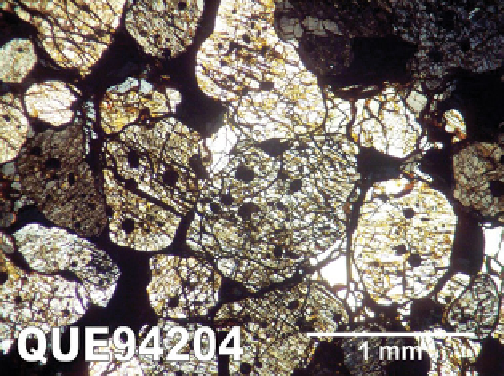Geology Reference
In-Depth Information
Ungrouped enstatite chondrite
2427.9 g
Found December 19, 1994
16.5 × 10.0 × 9.5 cm
Weathering = C
foundation for a new group of chondrites, once more are discovered.
However, there are several that have remained one-of-a-kind samples even
after close to 25 years in the collection. Among the enstatite meteorites
there are a few unusual ungrouped samples such as itqiy and QUE 94204
and its pairs. These unusual samples offer insight into the diversity of
materials in the solar system.
Plate 34
MiNERALogy
SigNiFiCANCE
QUE 94204 is composed of a granular aggregate of about
75% pyroxene (average grain size 1.5 mm), 20% nickel-
iron metal and troilite, and 5% intergranular plagioclase.
Some of the metal grains contain numerous inclusions of
graphite. Microprobe analyses show that the pyroxene is
close to MgSio
3
in composition, with a few more iron-
rich grains. Plagioclase composition is An
19-26
. The nickel-
iron metal contains 2.4%-2.9% Si.
The distinctive texture and mineralogy of QUE 94204
suggest both formation by impact melting and a poorly
understood mechanism of crystallization. With its milli-
meter-sized polysynthetically twinned enstatite crystals
and abundant interstitial metal, sulfide, and feldspar
(above, [232]), it is compositionally similar to enstatite
chondrites, yet its texture is distinctly igneous. Almost
certainly formed as a result of impact melting, the large,
rounded enstatites may suggest crystallization from a
superheated melt nearly devoid of relict silicate nuclei.
References [224-232]



